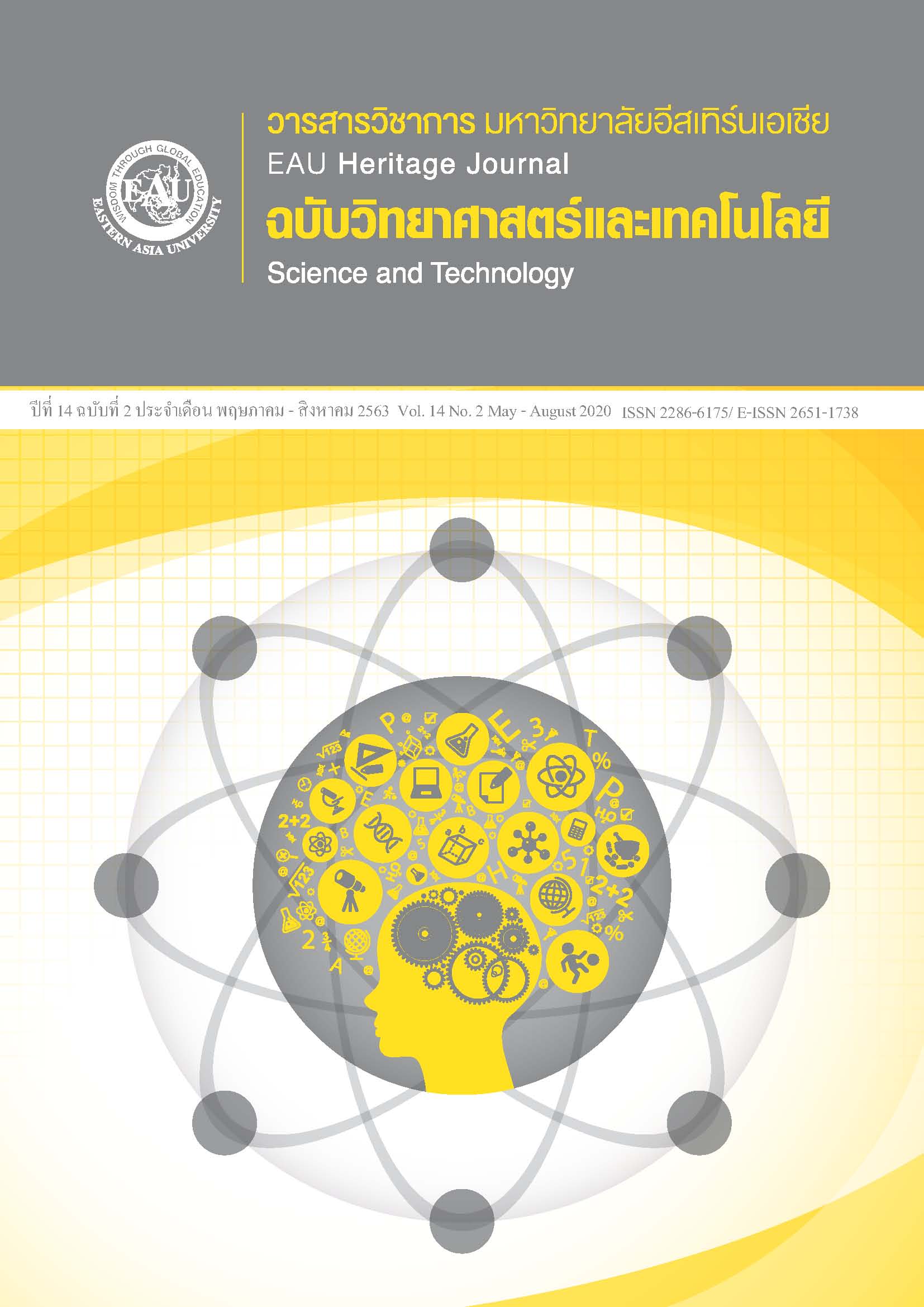The ไมโครพลาสติก : ปัญหาในระบบนิเวศแหล่งน้ำ
คำสำคัญ:
พลาสติก, ไมโครพลาสติก, ระบบนิเวศ, แหล่งน้ำบทคัดย่อ
พลาสติกสังเคราะห์ผลิตจากสารประกอบอินทรีย์และสารประกอบอนินทรีย์ เช่น คาร์บอน ซิลิกอนไฮโดรเจน ออกซิเจน คลอไรด์ และโลหะหนัก การแปรสภาพพลาสติกให้มีขนาดเล็กลงจนเป็นไมโครพลาสติกและนำไปใช้ประโยชน์สามารถแบ่งไมโครพลาสติกออกเป็น 2 ประเภท คือ ประเภทแรกเป็นองค์ประกอบในเครื่องสำอาง ที่เป็นเม็ดสครับ (microbeads) ใยเสื้อผ้า หรือในการผลิตอุตสาหกรรมพลาสติก ไมโครพลาสติกเหล่านี้สามารถแพร่กระจายสู่สิ่งแวดล้อมได้โดยการทิ้งของเสียโดยตรงจากบ้านเรือนสู่แหล่งน้ำและไหลสู่แหล่งน้ำทะเล ส่วนประเภทที่ 2 มาจากพลาสติกที่ใช้อยู่ทั่วไป เกิดการฉีกขาดจากปัจจัยต่าง ๆ เช่น แสง ความชื้น พลังงานจากคลื่น หรือสิ่งมีชีวิตในทะเล สลายเป็นเศษพลาสติกขนาดเล็ก และตกค้างสะสมก่อให้เกิดปัญหา และการปนเปื้อนต่อระบบนิเวศแหล่งน้ำในสิ่งแวดล้อม ดังนั้นวัตถุประสงค์ของบทความนี้เพื่อแสดงการปนเปื้อนสารไมโครพลาสติกในระบบนิเวศแหล่งน้ำโดยอาศัย สาเหตุ แหล่งที่มาของปัญหาการปนเปื้อนที่กระทบต่อความสัมพันธ์ในระบบนิเวศแหล่งน้ำ และเส้นทางการเชื่อมโยงในความสัมพันธ์ในระบบนิเวศแหล่งน้ำซึ่งเป็นปัจจัยสำคัญในการดำรงชีวิตของสิ่งมีชีวิตในน้ำ ประกอบไปด้วยแหล่งน้ำจืด น้ำกร่อย และน้ำเค็มที่มีความหลากหลายทางทรัพยากรชีวภาพของสิ่งมีชีวิต อาทิ พืชน้ำ สัตว์น้ำ สัตว์หน้าดิน ดินตะกอนท้องน้ำ น้ำใต้ดิน จุลินทรีย์ ที่มีการปนเปื้อนสารพิษและสารเคมีที่เกิดจากการสะสมของสารไมโครพลาสติกในน้ำ ถ้าไม่มีการป้องกัน จัดการ ควบคุม และดูแล จะส่งผลกระทบต่อสิ่งมีชีวิตในแหล่งน้ำอาจจะมีแนวโน้มที่รุนแรงเพิ่มสูงขึ้นในอนาคต และสามารถนำข้อมูลเป็นแนวทางในการวางแผนจัดการและป้องกันให้เหมาะสมต่อระบบนิเวศแหล่งน้ำและยั่งยืนต่อไป
เอกสารอ้างอิง
Andrady, A. L. (2011). Microplastics in the marine environment. Marine Pollution Bulletin, 62(8), 1596-1605. doi:10.1016/j.marpolbul.2011.05.030
Arthur, C., J. Baker & H. Bamford (Eds). (2009). Proceedings of the International Research Workshop on the Occurrence, Effects, and Fate of Microplastic Marine Debris. Sept 9-11, 2008. MD: NOAA Technical Memorandum NOS-OR&R-30.
Azad, S. M. O., Towatana, P., Pradit, S., Patricia, B. G., Hue, H. T., & Jualaong, S. (2018A). First evidence of existence of Microplastic in stomatch of some Commercial Fishes in the Lower Gulf of Thailand. Applied Ecology and Environmental Research, 16(6), 7345-7360.
Azad, S. M. O., Towatana, P., Pradit, S., Patricia, B. G., & Hue, H. T. (2018B). Ingestion of Microplastic by some Commercial Fishes in the Lower Gulf of Thailand: A prelimary approach to Ocean Conservation. International Journal of Agricultural Technology, 14(7), 1017–1032.
Barange, M., Field, J. G., Harris, R. P., Eileen, E., Hofmann, E. E., Perry, R. I., & Werner, F. (2010). Marine Ecosystems and Global Change. New York: Oxford University Press.
Browne, M. A., Galloway, T., & Thompson, R. (2007). Microplastician--an emerging contaminant of Potential concern?. Integrated Environmental Assessment and Management, 3(4), 559-561. doi: 10.1002/ieam.5630030412.
Browne, M. A., Dissanayake, A., Galloway, T. S., Lowe, D. M., & Thompson, C. R. (2008). Ingested Microscopic Plastic translocates to the circulatory system of the Mussel, Mytilus edulis (L). Environmental science & technology, 42(13), 5026-5031. doi: 10.1021/es800249a
Buranasingh, N. (2020). “Plastic Waste” a global problem that must be accelerated. Retrieved from https://www.parliament.go.th/ewtadmin/ewt/parliament_parcy/ewt_dl_link.php?nid=58603&filename=index. (in Thai)
Christensen, V., & D. Pauly (Eds.). (1993). Trophic models of Aquatic Ecosystems. ICLARM. Conference Proceedings No. 26 (p. 390). ICLARM. http://pubs.iclarm.net/libinfo/Pdf/Pub%20CP6%2026.pdf
Coastal and Mangrove Forest Resources Research and Development Institute and Faculty of Marine Technology Burapha University. (2014). Survey and classification of Marine Waste samples in the category of Micro-Plastics. Chon Buri: Department of Marine and Coastal Resources. (in Thai)
Cooper, D. A., & Corcoran, P. L. (2010). Effects of mechanical and chemical processes on the degradation of Plastic Beach Debris on the Island of Kauai, Hawaii. Marine Pollution Bulletin, 60, 650-654. doi:10.1016/j.marpolbul.2009.12.026
Cole, M., Lindeque, P., Halsband, C., & Galloway, T. S. (2011). Microplastics as contaminants in the Marine Environment: A review Mar. Pollut. Bull, 62, 2588–2597.
Donna, F. (2020). Microplastic pollution found in snow in the remotest corners of the world. Retrieved from https://interestingengineering.com/microplastic-pollution-found-in-snow-in-the-remotest-corners-of-the-world.
Graham, E. R., & Thompson, J. T. (2009). Deposit- and suspension-feeding Sea Cucumbers (Echinodermata) ingest Plastic fragments. Journal of Experimental Marine Biology and Ecology, 368(1), 22-29. doi: 10.1016/j.jembe.2008.09.007.
Greenpeace. (2020). Bad plastic the food chain threat. Retrieved from https://www.greenpeace.org/thailand/explore/resist/plastic/harm-plastic/. (in Thai)
Jochem, F. (2007). Zonation of the Benthal. Retrieved from http://www.jochemnet.de/fiu/OCB3043_32.html.
Kreekrinut, T., Puttapreecha, R., Suksuwan, R., Tangjai, R., & Saisahat, R. (2020). The contamination of Microplastic in sediment beach are Lower Gulf of Thailand. Retrieved from https://www.dmcr.go.th/download/?file. (in Thai)
Metropolitan Waterworks Authority. (2020). Micro-plastic in drinking water. Retrieved from https://www.mwa.co.th/ewt_dl_link.php?nid=34119. (in Thai)
Ramathibodi Poison Center. (2020). Dangers of the Plastics Industry. Retrieved from
https://med.mahidol.ac.th/poisoncenter/th/bulletin/bul99/v7n1/Monomer. (in Thai)
Shah, A. A., Hasan, F., Hameed, A., & Ahmed, S. (2008). Biological degradation of plastics: A comprehensive review. Biotechnology Advances, 26(3), 246–265. https://doi.org/10.1016/j.biotechadv.2007.12.005.
Tangchaiwattana, S. (2015). Type of Plastic. Bangkok: Physics and Engineering Project Department of Science Service. (in Thai)
Teuten, E. L., Rowland, S. J., Galloway, T. S., & C.Thompson, R. (2007). Potential for Plastics to transport Hydrophobic contaminants. Environmental Science & Technology, 41(22), 7759-7764. doi: 10.1021/es071737s.
Tharaman, P., Praisarnkul, S., & Leitpatom, N. (2016). Contamination of Micro-Plastic in Bivalve mollusk at Chao Lao beach and the beach at Kung Wiman Chanthaburi Province. Chanthaburi: Faculty of Marine Technology Burapha University Chanthaburi Campus. (in Thai)
Thitithanakorn, S. (2000). Plastic waste is waiting for the recycling industry. 53 Interesting mechanical techniques that set 7. Bangkok: M&E. (in Thai)
Thompson, R. C., Olsen, Y., Mitchell, R. P., Davis, A., Rowland, S. J., John, A. W. G., McGonigle, D., & Russell, A. E. (2004). Lost at sea: Where is all the Plastic?. Science, 304(5672), 838. doi:10.1126/science.1094559
The Bangkok Pathology-Laboratory Co.,Ltd (BPL). (2020). Danger from Plastic waste. Retrieved from
http://www.bioformthailand.com/TH/environment. (in Thai)
UNEP. (2008). Marine litter in the East Asian Seas Region-A report by the COBSEA Secretariat. London, United Kingdom: United Nations Environment Program.
United States. (2015). Microbead-Free Waters Act of 2015. Pub.L. 114–114. Approved 2015-12-28. Retrieved from https://uslaw.link/citation/us-law/public/114/114.
Wu, P., Huang, J., Zheng, Y., Yang, Y., Zhang, Y., He, F., Chen, H., Quan, G., Yan, J., Li, T., & Gao, B. (2019). Environmental occurrences, fate, and impacts of Microplastics. Ecotoxicology and Environmental Safety, 184, 109612. doi: 10.1016/j.ecoenv.2019.109612.







